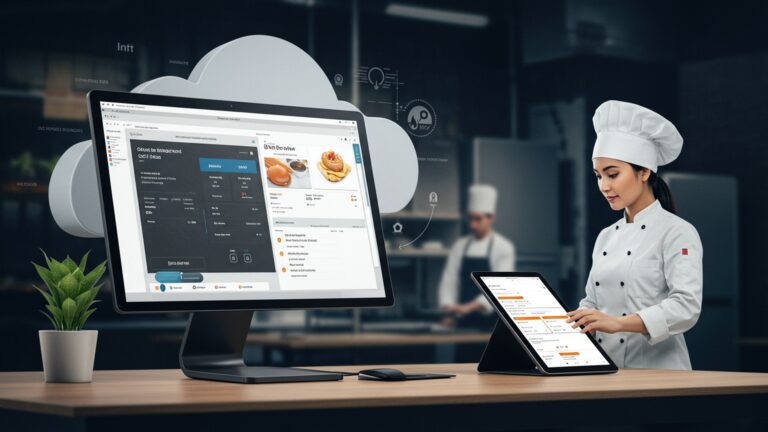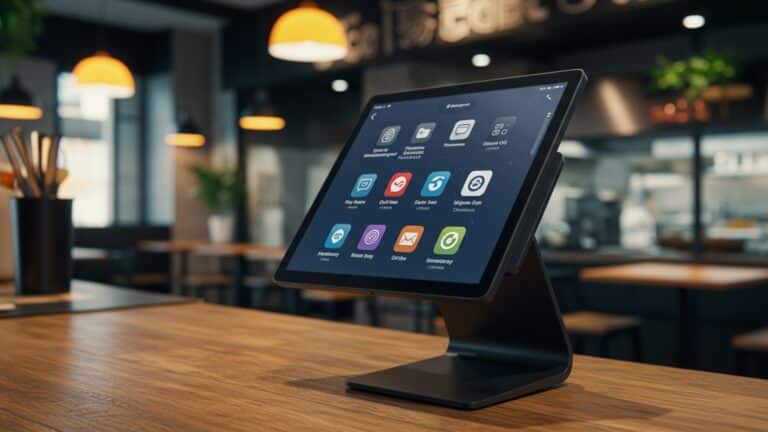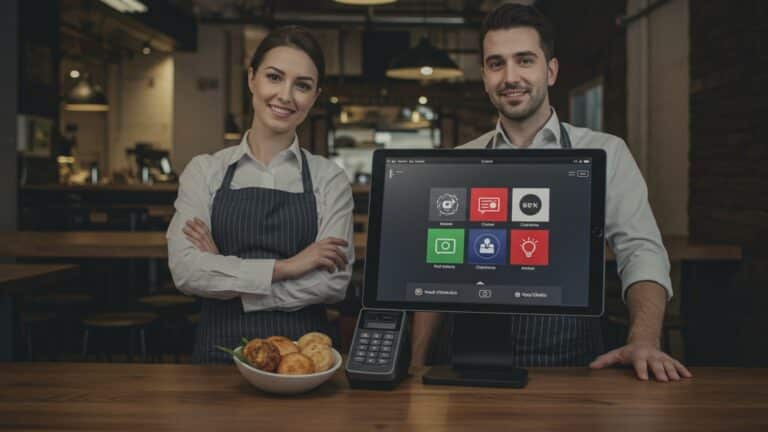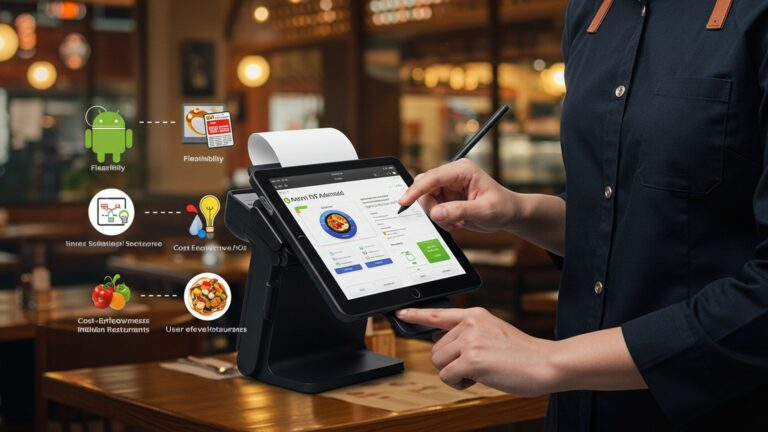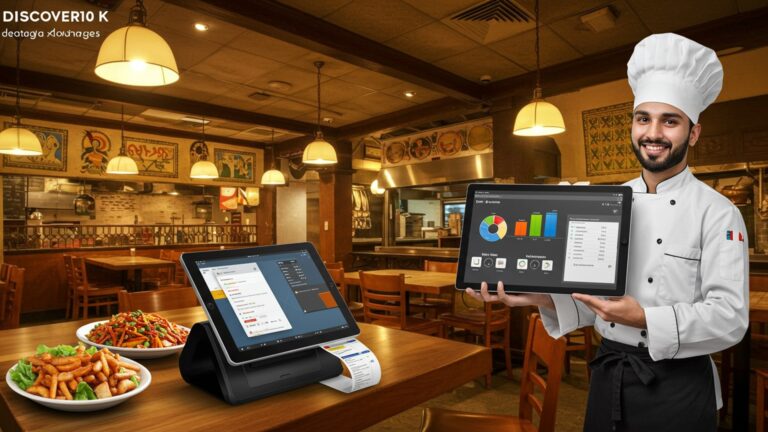7 Essential Features of Restaurant POS Software India for Seamless Operations
India’s dynamic restaurant industry, characterized by a rapid surge in online delivery platforms and evolving consumer expectations, demands far more than traditional billing systems. Modern Restaurant POS software India transforms operations, moving beyond simple transactions to become the central nervous system for establishments. With the widespread adoption of digital payments like UPI and the critical need for real-time inventory management to combat food waste, a robust POS solution now seamlessly integrates everything from efficient table management and kitchen display systems (KDS) to advanced analytics for personalized customer experiences. It empowers restaurateurs to navigate the complexities of GST compliance and multi-platform order aggregation, driving unprecedented efficiency and profitability in a fiercely competitive market.
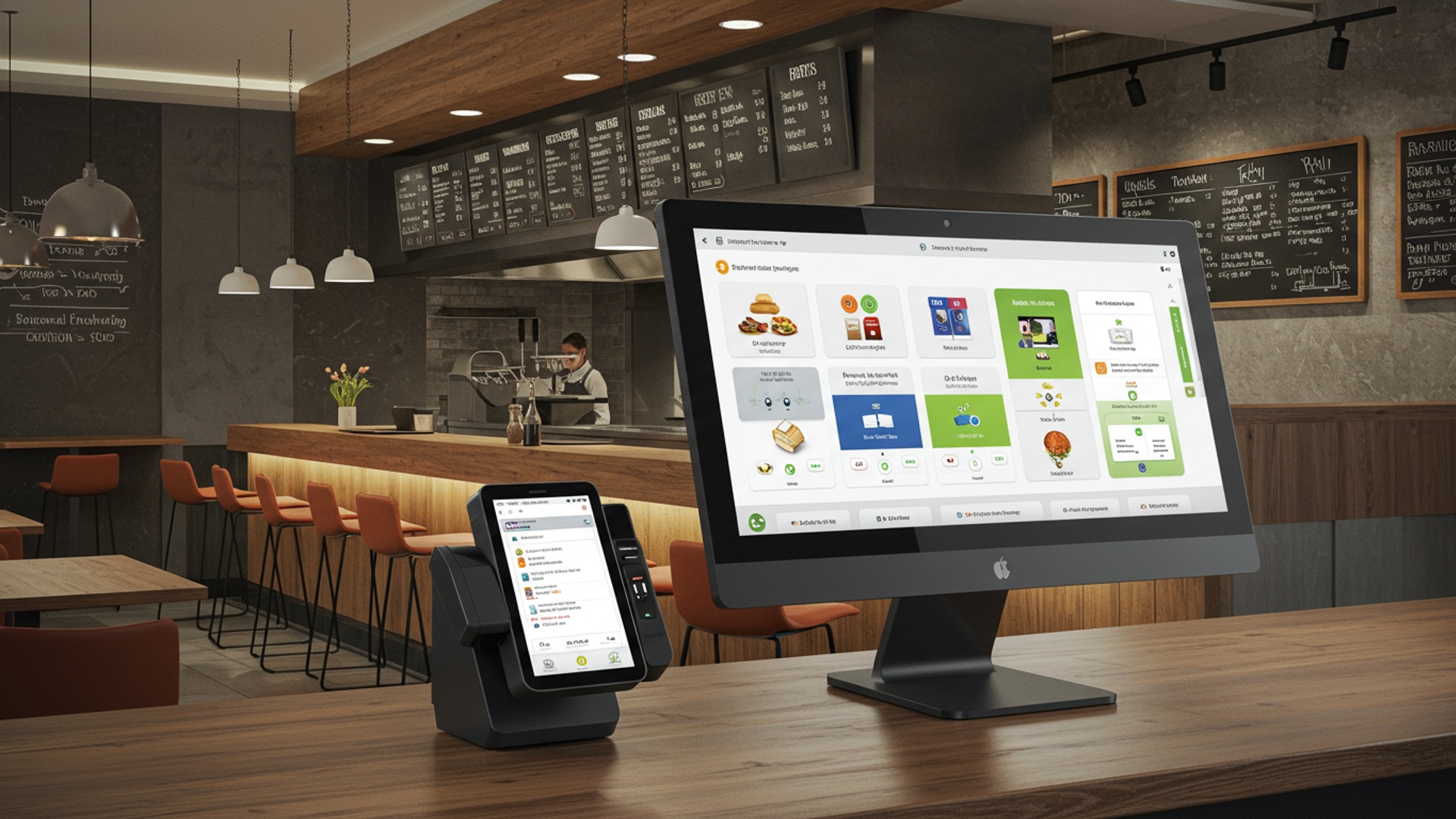
Streamlined Order Management and Kitchen Display System (KDS)
At the heart of any bustling restaurant is the flow of orders, from the customer’s choice to the kitchen’s execution. An essential feature of effective Restaurant POS software India is its robust order management system, often complemented by a Kitchen Display System (KDS). This core functionality dictates how smoothly your front-of-house communicates with the back-of-house, directly impacting service speed and accuracy.
Order management encompasses taking customer orders, modifying them, applying discounts. sending them to the kitchen or bar. A KDS is a digital screen system in the kitchen that displays incoming orders, replacing traditional paper KOTs (Kitchen Order Tickets). Each order item is shown, often with color-coding to indicate wait times or order status (e. g. , new, cooking, ready for pickup).
In India’s diverse culinary landscape, from quick-service restaurants (QSRs) to fine dining, order accuracy and speed are paramount. Miscommunications between servers and the kitchen can lead to wrong orders, delays. frustrated customers. A KDS, integrated with your Restaurant POS software India, ensures that:
- Orders are instantly transmitted to the relevant kitchen stations (e. g. , tandoor, continental, beverage).
- Cooks see all details, including modifications (e. g. , “less spicy,” “no onion”).
- Managers can track cooking times and identify bottlenecks in real-time.
- Food waste due to incorrect orders is significantly reduced.
Consider a popular South Indian restaurant in Bengaluru during peak lunch hours. Without a KDS, servers might struggle to communicate complex dosa orders with various fillings and chutneys, leading to errors. With an integrated Restaurant POS software India and KDS, each specific order is clearly displayed, ensuring patrons receive their exact requests promptly. This not only enhances customer satisfaction but also boosts table turnover, directly impacting revenue.
Comprehensive Inventory and Recipe Management
For any restaurant, controlling costs and minimizing waste is as critical as serving delicious food. This is where a powerful inventory and recipe management module within your Restaurant POS software India becomes indispensable. It’s not just about counting ingredients; it’s about intelligent procurement, precise portioning. preventing pilferage.
Inventory management tracks all raw materials and finished goods within your establishment. It monitors stock levels, tracks consumption. helps with reordering. Recipe management, often integrated, breaks down each menu item into its precise ingredient components and quantities. This allows the system to deduct ingredients from stock automatically when an item is sold.
Food costs are typically the largest variable expense for restaurants. Without accurate tracking, businesses risk overstocking perishable goods (leading to spoilage), understocking popular items (leading to lost sales), or experiencing internal theft. An effective Restaurant POS software India with this feature provides:
- Real-time Stock Visibility
- Automated Reorder Points
- Wastage Tracking
- Costing Analysis
- Vendor Management
Know exactly what you have. where.
Set minimum stock levels that trigger alerts for reordering.
Log spoiled or wasted items to identify problem areas.
Calculate the exact cost of each dish, helping with menu pricing and profitability.
Track supplier performance and purchase history.
Let’s take the example of a multi-cuisine restaurant in Mumbai. They use their Restaurant POS software India to manage everything from imported cheeses to local vegetables. When a “Butter Chicken” is sold, the system instantly deducts chicken, butter, cream. spices based on the predefined recipe. This not only maintains accurate stock but also highlights discrepancies if physical stock doesn’t match the system’s records, indicating potential issues like portion control problems or even pilferage. According to industry reports, efficient inventory management can reduce food costs by 2-5%, a significant saving for any F&B business.
Flexible Billing and Diverse Payment Options
In India’s rapidly evolving digital economy, offering a variety of payment options is no longer a luxury but a necessity. A modern Restaurant POS software India must facilitate quick, accurate billing and support multiple payment gateways to cater to every customer’s preference, from UPI to traditional cash.
This feature handles the generation of guest checks, application of discounts, service charges, taxes (like GST in India). the processing of various payment methods. It should also support splitting bills, merging tables. handling takeaways or deliveries with specific pricing structures.
Customer convenience directly translates to satisfaction. A clunky billing process or limited payment options can deter customers, especially the younger, digitally-savvy demographic. For businesses, errors in calculating GST or applying discounts can lead to financial losses or compliance issues. A robust Restaurant POS software India ensures:
- GST Compliance
- Multiple Payment Acceptance
- Split Bill Functionality
- Seamless Integrations
- Discount Management
Automatically calculates and applies Goods and Services Tax.
Supports cash, credit/debit cards, UPI (e. g. , Google Pay, PhonePe, Paytm), digital wallets. even loyalty points.
Allows customers to easily divide bills by item or evenly.
Connects with payment terminals and online payment gateways for quick transactions.
Effortlessly applies promotional offers, coupons, or employee discounts.
Consider a cafe in Pune that caters to a mix of students and professionals. Students often prefer UPI or digital wallets, while professionals might opt for credit cards. A Restaurant POS software India that seamlessly integrates all these options means faster checkouts, reduced queues. happier customers. Moreover, the ability to split bills easily among a group of friends, a common scenario in Indian dining, significantly enhances the dining experience. A study by Razorpay indicated a substantial increase in digital payments across various sectors in India, emphasizing the need for POS systems to be future-ready.
Integrated Customer Relationship Management (CRM) & Loyalty Programs
In a competitive market, retaining customers is often more cost-effective than acquiring new ones. An integrated CRM and loyalty program within your Restaurant POS software India allows you to comprehend your patrons better, personalize their experience. encourage repeat visits, building a loyal customer base.
CRM functionalities within a POS system help gather and manage customer data, including contact insights, purchase history, dietary preferences. visit frequency. Loyalty programs leverage this data to reward repeat customers through points, discounts, exclusive offers, or tiered membership benefits.
Personalization drives engagement. When a restaurant remembers a customer’s favorite dish or offers a special discount on their birthday, it creates a memorable experience. For businesses, this translates to:
- Increased Customer Retention
- Targeted Marketing
- Personalized Service
- Valuable Feedback Collection
Loyalty programs incentivize repeat visits.
Use purchase history to send relevant promotions (e. g. , “Try our new vegan options” to a customer who frequently orders vegetarian dishes).
Servers can access customer notes (e. g. , “allergic to nuts”) directly from the Restaurant POS software India.
Integrate feedback mechanisms to improve service.
Imagine a popular family restaurant in Delhi. Their Restaurant POS software India allows them to track that a particular family visits every month and always orders the same special thali. Through the loyalty program, they can automatically offer a discount on their 10th visit or send a personalized offer for an upcoming festival. This level of personalized engagement, facilitated by the POS system, transforms transactional interactions into lasting relationships. A report by KPMG highlights that customer loyalty programs can increase average customer spend by up to 15-20%.
Robust Reporting and Analytics
Data is the new currency. for restaurants, understanding operational data is key to sustained growth and profitability. A comprehensive Restaurant POS software India provides robust reporting and analytics tools that turn raw transaction data into actionable insights, empowering owners and managers to make informed decisions.
This feature generates various reports based on sales, inventory, labor, customer data. more. It often includes dashboards with visual representations (charts, graphs) of key performance indicators (KPIs) such as peak sales hours, best-selling dishes, average check size. inventory turnover.
Without data-driven insights, business decisions are often based on guesswork, leading to inefficiencies and missed opportunities. For an Indian restaurant operating in a dynamic market, understanding trends is vital. A sophisticated Restaurant POS software India offers:
- Sales Performance Analysis
- Inventory Variance Reports
- Profitability Reports
- Labor Cost Analysis
- Customer Behavior Insights
Identify top-selling items, busiest hours. server performance.
Compare actual stock with theoretical stock to pinpoint discrepancies.
grasp the margins on each dish, helping to optimize the menu.
Track employee hours and sales per employee to optimize staffing.
Identify loyal customers, popular dishes. peak dining times.
Consider a chain of cafes across Bengaluru. Their central Restaurant POS software India aggregates data from all outlets. Management can pull a report showing that “Masala Chai” sells significantly more in the Indiranagar branch during morning hours, while “Cold Coffee” dominates evening sales in the Koramangala outlet. This data helps them tailor promotions, optimize staffing. manage inventory more effectively for each location. For instance, a simple query to find the top 5 selling items could look conceptually like:
SELECT item_name, SUM(quantity_sold) AS total_sold, SUM(total_price) AS total_revenue
FROM sales_transactions
WHERE transaction_date BETWEEN '2023-01-01' AND '2023-03-31'
GROUP BY item_name
ORDER BY total_revenue DESC
LIMIT 5;
While this is a database query example, the POS system’s reporting module would provide a user-friendly interface to generate such insights without needing technical knowledge.
Multi-Outlet and Centralized Management
As restaurants grow from a single outlet to multiple branches, the complexity of operations multiplies. A truly essential feature of modern Restaurant POS software India for expanding businesses is its ability to provide centralized control and management across all locations. This enables consistency, efficiency. scalability.
Multi-outlet management allows a single POS system to manage operations for several restaurant branches from a central dashboard. This includes managing menus, inventory, pricing, employee data. reporting across all locations, even if they are geographically dispersed. Often, cloud-based Restaurant POS software India solutions excel in this area.
Without centralized control, maintaining brand consistency, standardizing operations. analyzing overall business performance becomes incredibly challenging. Each outlet might operate in a silo, leading to disparate data, inconsistent customer experiences. fragmented decision-making. Centralized management through a robust Restaurant POS software India provides:
- Standardized Menus & Pricing
- Centralized Inventory
- Unified Reporting
- Employee Management
- Scalability
Ensure consistent offerings and pricing across all branches.
Manage and transfer stock between outlets, or consolidate procurement.
Access real-time sales, inventory. labor reports for all locations from one dashboard.
Manage staff rosters, permissions. performance across the entire chain.
Easily add new outlets to the system as the business expands.
Consider a popular biryani chain with 15 outlets across Hyderabad. Before adopting a centralized Restaurant POS software India, each outlet managed its own inventory and menu, leading to inconsistent pricing and difficulty in tracking overall profitability. With a centralized system, they can update a menu item’s price across all 15 outlets simultaneously, monitor stock levels in each kitchen. generate consolidated sales reports for the entire chain. This provides a holistic view of the business, allowing for strategic decisions like identifying underperforming outlets or launching new dishes across the entire brand efficiently.
Seamless Third-Party Integrations
The modern restaurant ecosystem extends far beyond the four walls of the dining area. From online food delivery platforms to accounting software, a Restaurant POS software India must be able to seamlessly integrate with a variety of third-party applications to create a truly connected and efficient operation.
Integration capabilities refer to the POS system’s ability to connect and exchange data with other software platforms used by the restaurant. These often include online ordering platforms (e. g. , Zomato, Swiggy), accounting software (e. g. , Tally, Zoho Books), payroll systems, reservation platforms. marketing tools.
Manual data entry between disparate systems is a major source of errors, inefficiency. wasted time. For example, manually entering online orders into the POS or transferring daily sales data to accounting software is time-consuming and prone to mistakes. Seamless integration via a robust Restaurant POS software India ensures:
- Automated Online Order Flow
- Accurate Financial Reporting
- Efficient Reservation Management
- Enhanced Marketing
- Reduced Errors & Time Savings
Orders from Zomato or Swiggy are directly pushed to the KDS and POS, eliminating manual entry.
Sales data automatically syncs with accounting software, simplifying bookkeeping and tax compliance.
Integrated reservation systems update table availability in real-time.
Customer data from the POS can be pushed to marketing platforms for targeted campaigns.
Eliminates duplicate data entry and manual reconciliation efforts.
Let’s look at a cloud kitchen in Chennai that relies heavily on online delivery. Their Restaurant POS software India is integrated with major food aggregators. When a customer places an order on Swiggy, it instantly appears on the kitchen’s KDS and is registered in the POS system for billing and inventory deduction. This eliminates the need for staff to manually re-enter orders, saving precious minutes during peak hours and drastically reducing errors. Moreover, , all sales data automatically syncs with their Tally accounting software, simplifying their daily reconciliation and financial reporting. This comprehensive connectivity is a hallmark of truly advanced Restaurant POS software India, enabling businesses to thrive in a multi-channel environment.
| Integration Type | Benefit to Restaurant | Example Platforms (India) |
|---|---|---|
| Online Food Delivery | Automated order processing, wider reach | Zomato, Swiggy, Magicpin |
| Accounting Software | Automated sales reconciliation, tax compliance | Tally ERP, Zoho Books, QuickBooks |
| Reservation Systems | Streamlined table management, reduced no-shows | Dineout, EazyDiner |
| Payment Gateways | Diverse payment options, secure transactions | Razorpay, PayU, Paytm Business |
| Loyalty & CRM | Personalized marketing, customer retention | Built-in POS CRM, external marketing automation tools |
Conclusion
Mastering the 7 essential features of restaurant POS software isn’t merely about adopting technology; it’s about strategically equipping your Indian eatery for future success. From real-time inventory management, crucial for minimizing wastage of high-value ingredients like imported cheeses or fresh seafood, to seamless online ordering integration, vital in today’s Swiggy-Zomato dominated landscape, each feature plays a pivotal role. I’ve personally witnessed how a robust system with integrated Kitchen Display Systems (KDS) drastically cuts down order errors during peak dinner rushes, transforming chaotic kitchens into smooth operations. My personal tip? Don’t just look for features; prioritize a POS that offers scalable cloud-based solutions, allowing you to manage multiple outlets or adapt to surging demand, a critical consideration given India’s dynamic F&B market trends. Evaluate systems that provide insightful analytics, enabling data-driven decisions on menu pricing or staff scheduling. Your immediate action should be to meticulously assess your current setup against these benchmarks or, if starting new, invest in a system that truly future-proofs your establishment. Remember, the right POS isn’t an expense; it’s the cornerstone for enhanced customer satisfaction and sustained profitability in a competitive market.
More Articles
How to Select the Best Billing and POS Software for Your Business
Learn 5 Essential Online Ordering POS India Features for Your Restaurant
Master Restaurant Billing Software India Choose Your Perfect System
Discover 7 Affordable Restaurant POS India Solutions for Small Businesses
FAQs
Why should my Indian restaurant bother with POS software?
It’s super crucial for streamlining daily tasks, from taking orders to managing inventory and payments. It helps cut down on errors, speed up service. ultimately improve your customer experience and boost your bottom line.
How does POS software help with managing orders in a busy Indian restaurant setup?
Good POS software lets your staff quickly take orders, send them directly to the kitchen or bar via KOT/BOT. even modify them easily. This significantly reduces manual errors and ensures orders reach the right place instantly, speeding up service during peak hours.
Can a POS system really help me keep track of all my ingredients and stock effectively?
Absolutely! Modern POS systems offer robust inventory management. You can track ingredients in real-time, get alerts for low stock, manage recipes. even identify popular or slow-moving items. This helps reduce waste, optimize purchases. keep your kitchen running smoothly.
What kind of payment options can a restaurant POS system handle in India?
A good POS system in India supports a wide range of payment methods to cater to every customer. This typically includes cash, credit/debit cards, UPI, various mobile wallets. the ability to easily split bills. It makes the checkout process quick and convenient for everyone.
I want to grasp my restaurant’s performance better. How does POS software help with that?
POS software generates detailed reports on sales, peak hours, popular dishes, staff performance. much more. These insights are invaluable for making informed business decisions, optimizing your menu, identifying areas for improvement. generally running your restaurant smarter.
Is it easy to manage tables and seating arrangements with this kind of software?
Yes, many POS systems come with intuitive table management features. You can see a visual layout of your restaurant, check table status (occupied, vacant, pending bill), assign servers. even combine or split tables. This makes managing seating arrangements and guest flow a breeze.
Does this software offer anything to keep my customers coming back for more?
Definitely! Many POS systems include features like customer databases, loyalty programs. discount management. You can track customer preferences, offer personalized deals. build stronger relationships, which really encourages repeat visits and builds a loyal customer base.


